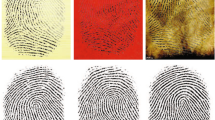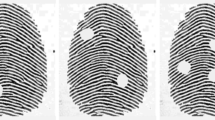Abstract
Distortions such as dryness, wetness, blurriness, physical damages and presence of dots in fingerprints are a detriment to a good analysis of them. Even though fingerprint image enhancement is possible through physical solutions such as removing excess grace on the fingerprint or recapturing the fingerprint after some time, these solutions are usually not user-friendly and time consuming. In some cases, the enhancements may not be possible if the cause of the distortion is permanent. In this paper, we are proposing an unpaired image-to-image translation using cycle-consistent adversarial networks for translating images from distorted domain to undistorted domain, namely, dry to not-dry, wet to not-wet, dotted to not-dotted, damaged to not-damaged, blurred to not-blurred. We use a database of low quality fingerprint images containing 11541 samples with dryness, wetness, blurriness, damages and dotted distortions. The database has been prepared by real data from VISA application centres and have been provided for this research by GEYCE Biometrics. For the evaluation of the proposed enhancement technique, we use VGG16 based convolutional neural network to assess the percentage of enhanced fingerprint images which are labelled correctly as undistorted. The proposed quality enhancement technique has achieved the maximum quality improvement for wetness fingerprints in which 94% of the enhanced wet fingerprints were detected as undistorted.













Similar content being viewed by others
References
Barman S, Chattopadhyay S, Samanta D, Bag S, Show G (2014) An efficient fingerprint matching approach based on minutiae to minutiae distance using indexing with effectively lower time complexity. In: 2014 international conference on information technology (ICIT). IEEE, pp 179–183
Bolotnikova A, Demirel H, Anbarjafari G (2017) Real-time ensemble based face recognition system for nao humanoids using local binary pattern. Analog Integr Circ Sig Process 92(3):467–475
Cao K, Jain AK (2018) Automated latent fingerprint recognition. IEEE Trans Pattern Anal Mach Intell
Cao K, Liu E, Pang L, Liang J, Tian J (2011) Fingerprint matching by incorporating minutiae discriminability. In: 2011 international joint conference on biometrics (IJCB). IEEE, pp 1–6
Cappelli R, Ferrara M, Maltoni D (2010) Minutia cylinder-code: a new representation and matching technique for fingerprint recognition. IEEE Trans Pattern Anal Mach Intell 32(12):2128–2141
Cappelli R, Ferrara M, Maltoni D, Tistarelli M (2010) Mcc: a baseline algorithm for fingerprint verification in fvc-ongoing. In: 2010 11th international conference on control automation robotics & vision (ICARCV). IEEE, pp 19–23
Cappelli R, Ferrara M, Maltoni D, Turroni F (2011) Fingerprint verification competition at ijcb2011. In: 2011 international joint conference on biometrics (IJCB). IEEE, pp 1–6
Chugh T, Arora SS, Jain AK, Paulter NG Jr (2017) Benchmarking fingerprint minutiae extractors. BIOSIG 2017
Demirel H, Anbarjafari G (2009) Data fusion boosted face recognition based on probability distribution functions in different colour channels. EURASIP J Adv Signal Process 2009:25
Dorizzi B, Cappelli R, Ferrara M, Maio D, Maltoni D, Houmani N, Garcia-Salicetti S, Mayoue A (2009) Fingerprint and on-line signature verification competitions at icb 2009. In: International conference on biometrics. Springer, pp 725–732
Feng J (2008) Combining minutiae descriptors for fingerprint matching. Pattern Recogn 41(1):342–352
GEYCE biometrics. http://bioidenti.com/en/home/. Accessed 10 April 2018
Goodfellow I, Pouget-Abadie J, Mirza M, Xu B, Warde-Farley D, Ozair S, Courville A, Bengio Y (2014) Generative adversarial nets. In: Advances in neural information processing systems, pp 2672–2680
Haamer RE, Kulkarni K, Imanpour N, Haque MA, Avots E, Breisch M, Nasrollahi K, Escalera S, Ozcinar C, Baro X et al (2018) Changes in facial expression as biometric: a database and benchmarks of identification. In: 2018 13th IEEE international conference on automatic face & gesture recognition (FG 2018). IEEE, pp 621–628
He Z, Zhao X, Zhang S (2015) Low-quality fingerprint recognition using a limited ellipse-band-based matching method. JOSA A 32(6):1171–1179
Hong L, Wan Y, Jain A (1998) Fingerprint image enhancement: algorithm and performance evaluation. IEEE Trans Pattern Anal Mach Intell 20(8):777–789
Isola P, Zhu J-Y, Zhou T, Efros AA (2017) Image-to-image translation with conditional adversarial networks. In: 2017 IEEE conference on computer vision and pattern recognition (CVPR). IEEE, pp 5967–5976
Ito K, Morita A, Aoki T, Higuchi T, Nakajima H, Kobayashi K (2005) A fingerprint recognition algorithm using phase-based image matching for low-quality fingerprints. In: IEEE international Conference on image Processing, 2005. ICIP 2005, vol 2. IEEE, pp II–33
Jahromi MN, Bonderup MB, Asadi-Aghbolaghi M, Avots E, Nasrollahi K, Escalera S, Kasaei S, Moeslund TB, Anbarjafari G (2018) Automatic access control based on face and hand biometrics in a non-cooperative context. In: 2018 IEEE winter applications of computer vision workshops (WACVW). IEEE, pp 28–36
Ji L, Yi Z (2008) Fingerprint orientation field estimation using ridge projection. Pattern Recogn 41(5):1491–1503
Kar NB, Babu KS, Sangaiah AK, Bakshi S (2017) Face expression recognition system based on ripplet transform type ii and least square svm. Multimed Tools Appl:1–24
Kingma DP, Ba J (2014) Adam: a method for stochastic optimization. arXiv:1412.6980
Krizhevsky A, Sutskever I, Hinton GE (2012) Imagenet classification with deep convolutional neural networks. In: Advances in neural information processing systems, pp 1097–1105
Litvin A, Nasrollahi K, Ozcinar C, Guerrero SE, Moeslund TB, Anbarjafari G (2019) A novel deep network architecture for reconstructing rgb facial images from thermal for face recognition. Multimed Tools App
Loob C, Rasti P, Lüsi I, Junior JCJ, Baró X, Escalera S, Sapinski T, Kaminska D, Anbarjafari G (2017) Dominant and complementary multi-emotional facial expression recognition using c-support vector classification. In: 2017 12th IEEE international conference on automatic face & gesture recognition (FG 2017). IEEE, pp 833–838
Marasco E, Ross A (2015) A survey on antispoofing schemes for fingerprint recognition systems. ACM Computing Surveys (CSUR) 47(2):28
Nandakumar K (2012) Fingerprint matching based on minutiae phase spectrum. In: 2012 5th IAPR international conference on biometrics (ICB). IEEE, pp 216–221
Nasrollahi K, Distante C, Hua G, Cavallaro A, Moeslund T, Battiato S, Ji Q (2017) Video analytics. In: Face and facial expression recognition and audience measurement: third international workshop, VAAM 2016, and second international workshop, FFER 2016, Cancun, Mexico, December 4, 2016, revised selected papers. Springer, vol 10165
Parziale G, Niel A (2004) A fingerprint matching using minutiae triangulation. In: Biometric authentication. Springer, pp 241–248
Peralta D, Galar M, Triguero I, Paternain D, García S, Barrenechea E, Benítez JM, Bustince H, Herrera F (2015) A survey on fingerprint minutiae-based local matching for verification and identification: taxonomy and experimental evaluation. Inf Sci 315:67–87
Radford A, Metz L, Chintala S (2015) Unsupervised representation learning with deep convolutional generative adversarial networks. arXiv:1511.06434
Rasti P, Uiboupin T, Escalera S, Anbarjafari G (2016) Convolutional neural network super resolution for face recognition in surveillance monitoring. In: International conference on articulated motion and deformable objects. Springer, pp 175–184
Schuch P, Schulz S-D, Busch C (2017) Intrinsic limitations of fingerprint orientation estimation. BIOSIG 2017
Song D, Tang Y, Feng J (2019) Aggregating minutia-centred deep convolutional features for fingerprint indexing. Pattern Recogn 88:397–408
Tertychnyi P, Ozcinar C, Anbarjafari G (2018) Low-quality fingerprint classification using deep neural network. IET Biometrics 7(6):550–556
Tico M, Kuosmanen P (2003) Fingerprint matching using an orientation-based minutia descriptor. IEEE Trans Pattern Anal Mach Intell 25(8):1009–1014
Ratha N, Bolle R (2003) Automatic fingerprint recognition systems. Springer Science & Business Media, Berlin
Ronneberger O, fischer P, Brox T (2015) U-net: convolutional networks for biomedical image segmentation. In: International conference on medical image computing and computer-assisted intervention. Springer, pp 234–241
Willis AJ, Myers L (2001) A cost-effective fingerprint recognition system for use with low-quality prints and damaged fingertips. Pattern Recogn 34(2):255–270
Yang J, Xiong N, Vasilakos AV (2013) Two-stage enhancement scheme for low-quality fingerprint images by learning from the images. IEEE Trans Human-Mach Sys 43(2):235–248
Yao Z, Le Bars J-M, Charrier C, Rosenberger C (2016) Literature review of fingerprint quality assessment and its evaluation. IET Biometrics 5(3):243–251
Zhang N, Zang Y, Jia X, Yang X, Tian J (2016) Define a fingerprint orientation field pattern. In: 2016 23rd international conference on pattern recognition (ICPR). IEEE, pp 937–942
Zhang F, Xin S, Feng J (2017) Deep dense multi-level feature for partial high-resolution fingerprint matching. In: 2017 IEEE international joint conference on biometrics (IJCB). IEEE, pp 397–405
Zhou J, Gu J (2004) A model-based method for the computation of fingerprints’ orientation field. IEEE Trans Image Process 13(6):821–835
Zhu J-Y, Park T, Isola P, Efros AA (2017) Unpaired image-to-image translation using cycle-consistent adversarial networks
Author information
Authors and Affiliations
Corresponding author
Additional information
Publisher’s note
Springer Nature remains neutral with regard to jurisdictional claims in published maps and institutional affiliations.
This work has been partially supported by the COST Action CA16101 Multi-modal Imaging of Forensic Science Evidence -tools for Forensic Science, the Scientific and Technological Research Council of Turkey (TÜBITAK) 1001 Project (116E097), and the Estonian Centre of Excellence in IT (EXCITE) funded by the European Regional Development Fund. The authors also gratefully acknowledge the support of NVIDIA Corporation with the donation of the Titan V Pascal GPU.
Rights and permissions
About this article
Cite this article
Karabulut, D., Tertychnyi, P., Arslan, H.S. et al. Cycle-consistent generative adversarial neural networks based low quality fingerprint enhancement. Multimed Tools Appl 79, 18569–18589 (2020). https://doi.org/10.1007/s11042-020-08750-8
Received:
Revised:
Accepted:
Published:
Issue Date:
DOI: https://doi.org/10.1007/s11042-020-08750-8




